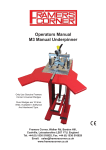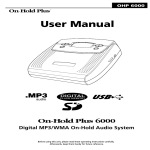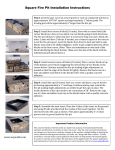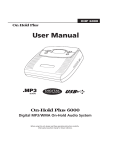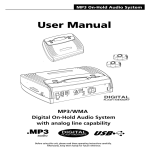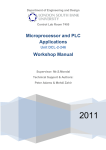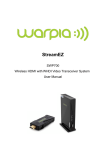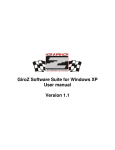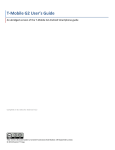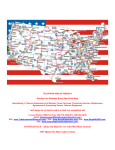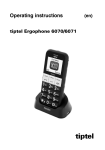Download Operators Manual P5 Pneumatic Underpinner
Transcript
Operators Manual P5 Pneumatic Underpinner Framers Corner, Walker Rd, Bardon Hill, Coalville, Leicestershire LE67 1TU, England Tel. 01530 516925, Fax. 01530 516929 Email: [email protected] P5 Technical Specification Moulding Width (Using Rebate Clamp) Moulding Width (Without Clamp) Moulding Height Pin Placement from Back Corner Wedge Sizes Air Supply Pressure Underpinner Dimensions (WxDxH) Weight Warranty 0-70mm 0-110mm 0-100mm 0-120mm 5 to 15mm 6 - 8bar (90-115psi) 730mm x 800mm x 1110mm 60kg 1 year GENERAL SAFETY RULES WARNING: Do not attempt to operate the machine until you have read thoroughly and understood completely all instructions, rules, etc. contained in this manual. Failure to comply may result in accidents involving serious personal injury. Keep this owner's manual and review frequently for continuous safe operation. 1. Know your machine. For your own safety, read the owner's manual carefully. Learn its application and limitations, as well as specific potential hazards pertinent to this machine. 2. Keep guards in place and in working order. If a guard must be removed for maintenance or cleaning, make sure it is properly replaced before using the machine again. 3. Remove adjusting keys and spanners. Form a habit of checking to see that the keys and adjusting spanners are removed from the machine before operating it. 4. Keep your work area clean. Cluttered areas and workbenches increase the chance of an accident. 5. Do not use in dangerous environments. Do not use power tools in damp or wet locations, or expose them to rain. Keep work areas well illuminated. 6. Keep children away. All visitors should be kept a safe distance from the work area. 7. Use the right tools. Do not force the machine or attachments to do a job for which they are not designed. Contact the manufacturer or distributor if there is any question about the machine's suitability for a particular job. 8. Wear proper apparel. Avoid loose clothing, gloves, ties, rings, bracelets, and jewellery which could get caught in moving parts. Non-slip footwear is recommended. Wear protective hair covering to contain long hair. 9. Always use safety glasses. Normal spectacles only have impact resistant lenses. They are not safety glasses. 10. Do not over-reach. Keep proper footing and balance at all times. 11. Maintain machine in good condition. Keep machine clean for best and safest performance. Follow instructions for lubrication and maintenance. 12. Disconnect the machine from power or source (or air supply) before servicing. 13. Never leave the machine unattended with the air supply connected. 14. Do not use any power tools while under the effects of drugs, alcohol or medication. Page 2 Unpacking Your Underpinner Check the contents have arrived safely and all the components are present according to the list below. A B C D I G E F H K J M L N Large Parts A) Accessory Tray B) Safety Guard C) Front Stop Bar D) Spanner E) Clamp Adjuster F) Vertical Bar G) Handle H) Washer I) L Shaped Pad J) Round Pad K) Left Table L) Front Clamp M) Right Table N) Rubber Feet x 4 O P Q R U S T Small Parts O) Cap Head Bolt x 8 P) Washer x 8 Q) Locking Collar R) Locking Handle S) Brass Nipple T) Magentic Tool U) Set of Hex Keys Page 3 MAIN FEATURES OF THE P5 UNDERPINNER Clamp Height Adjuster Top Clamp Lock Fence Lock Top Clamp Pad Front Wedge Position Lock Guard Front Clamp Sliding Fence Main Table Side Table Rear Wedge Position Lock Magazine Feeder Anchor Bolt Wedge Size Selector ASSEMBLY INSTRUCTIONS 1) Fit the Rubber Feet Screw 4 feet (N) into threaded holes in the base of the stand. The feet are adjustable in height. Use a 13mm spanner to tighten the locking nut, once the machine has been levelled. Insert the Front Stop Bar (C) into the hole in the fence block. Place the Brass Nipple (S) into the threaded hole in the fence block. 2) Assemble the Fence Fit the Handle and Locking Collar (Q) over the right hand fence bar. Page 4 Screw in the Locking Handle (R). 4) Assemble the Front Clamp Position the Front Clamp (L) so that one of the round holes aligns over the Clamp Pusher. Clamp Pusher 3) Assemble the Top Clamp Fit the Clamp Adjuster (E) onto the bridge and secure in place with Washer (H) and Handle (G). Push the Button on the front of the Clamp Adjuster and insert, from above, the Vertical Bar (F). Screw the L Shaped Pad (I) onto the end of the vertical bar. 5) Assemble the Side Tables Use 8 Cap Head Bolts (O) and Washers (P) to fit the 2 Side Tables (K&M). Use a straight edge to set the level of the tables flush with the main table. 6) Fit the accessory tray Undo the two cap head bolts, located on the left hand side of the body, and use them to secure the Accessory Tray (A). Store the service tools and spare wedges here. sh Pu Page 5 7) Fit the guard Remove the two thumb screws and use them to fit into the slots in the transparent Guard (B). The guard is hinged and lifts up to allow access when making adjustments to the machine. OPERATING INSTRUCTIONS Caution: Be Aware the Top Bridge of the Pinner will raise sharply as the supply is connected. 1) Connect to an Air Supply This machine requires an air supply of between 6-8bar (90-115psi). Connect a hose using a Framers Corner quick action coupler (C412 Not supplied). Alternatley you can change the fitting to match the type used in your workshop by simply unscrewing the plug and replacing it with your own. The thread size is 1/4”. Please Note: The machine will only operate when the guard is closed and magnetically latched against the sensor. Adjust the pressure regulator. The pinner is fitted with a pressure gauge. When an air supply is connected the gauge should read between 6-8bar. (otherwise see trouble shooting guide) Sensor 2) Set the Fence The fence will slide smoothly forward and back. This allows wedges to be inserted into any position on the moulding. The fence is fitted with a limit stop to set the front wedge position and a limit stop to set the rear wedge position. Fence Lock Front Stop Rear Stop Page 6 When inserting only one wedge into a corner, the position should be central. 3) Select the Appropriate Sized Wedge The P5 can use wedge (V-nail) sizes 5mm, 7mm, 10mm, 12mm and 15mm. Please Note: Only use Universal type wedges supplied in glued strips 1/2 L L When inserting 2 or more wedges into a corner the first position should be 1/4 distance from the front edge. The last position should be 1/3rd distance from the back edge. There must be a mimumum of 2mm between the top of the inserted wedge and the face of the moulding. 2mm Minimum 1/3 L 1/4 L L There is also a lock to hold the current position. This is used when ‘stacking’ wedges. Stacking is the process of inserting multiple wedges in the same position. The second, and subsequent wedges, will drive the first wedge deeper creating a stack. Using this method 2 x10mm high wedges will become a 20mm high wedge. Single Wedge 4) Load the Magazine Adjust the wedge selector located on the right hand side of the machine to the match the size of wedge to be used. Stacked Wedges Page 7 Pull back the nylon cord and hook the looped end over the anchor bolt. Insert a strip of wedges, sharpened side upwards. When using genuine Framers Corner Wedges, insert with glued side up. To remove wedges from the magazine, reverse the proceedure. Use the Magnetic Tool (T) to pull the partly used strip of wedges, out of the magazine. 5) Set the Front Clamp The front clamp grips the moulding by the rebate. The clamp holds the moulding securely even when moving from one wedge position to another. Place a piece of the moulding to be used against the fence. Press and hold down the right hand footpedal. The clamp pusher will travel backwards. Fit the clamp over the clamp pusher, in such a way that tip of the clamp is within 25mm of the moulding. Unhook the nylon cord and gently let the spring push the strip of wedges into the magazine. Use visual observation to confirm that the wedges slide under the cover plate with a gap of no more than 0.5mm. m 25 m 0.5mm Gap Only Release the foot pedal and the clamp will move forward, gripping the moulding. The tip of the clamp is desgined to allow for slight variations in the moulding width. Page 8 6) Choose the Appropriate Rubber Pad The pinner is supplied with 2 rubber pads. For flat moulding the round pad is generally better. For profiled moulding with varying heights the L shaped pad is generally better. 5mm Gap Round Pad L Shape Pad The machine is deactivated until the guard is lowered into position and magnetically locked against the sensor switch. 7) Set the Top Clamp It is important to set the height of the top clamp correctly. Place the moulding to be used against the fence. Set the gap between the lowest point of the moulding and the underside of the rubber pad to 20mm. The maximum travel of the clamp is 30mm. To adjust the height press the button and slide the clamp up or down. Sensor 20mm Gap 9) Positioning the Foot Pedal The foot pedal can be used on the left or right hand side of the machine. when working with very large frames, it may be more convenient to work from behind the machine with the pedal turned round. 8) Set the Guard The purpose of the transparent guard is to ensure the operators hands are well away from the danger area and to prevent accidental operation of the machine. The height of the guard should be set within 5mm of the highest point of the moulding, and is adjusted using two thumb nuts. Page 9 ROUTINE MAINTENANCE 10) Insert the Wedge With all the above settings made: l Push the fence into the back position l Press down the right hand pedal l Place 2 mitred pieces against the fence l Release the pedal l Use the inspection mirror to check the joint Mirror Caution: Always disconnect the air supply before starting any maintenance 1) Cleaning Clean any excess wood glue from around the wedge exit point. Clean the top of the table using a silicone spray or similar product to allow the fence to slide smoothly. 2) Clearing a blockage Occasionally, a wedge may get jammed in the magazine. It may be possible to pull the wedges out by hand. If it is firmly stuck, possibly half in and half out, It is highly likely that the driver will also be stuck in the raised position. To clear the blockage, use an 8mm spanner to remove the Cap. l Press and hold the left hand pedal Cap During the cycle the top clamp will travel down and contact the moulding, then the driver will push one wedge into the underside of the moulding. l Release the pedal If more than 1 wedge is to be inserted into the corner, wait for the cycle to finish, pull the fence and moulding into the front position and press the pedal again. Please note: It is recommended that a wood glue is always used when making a frame. Apply a small amount of glue to one of the mitred ends before loading into the pinner. The glue will give the frame strength and ensure it lasts for many years. Once removed, the driver should drop back down and the jammed wedge can easily be removed. When refitting the cap, ensure the top is flush with the surface of the surrounding table. 3) Replacing the Driver The driver is the part which takes the most wear and will, one day, need replacing. i) Disconnect the air supply. ii) Use an 8mm spanner to remove the Cap. iii) Undo the hex bolt which secures the bottom of the driver to the driver holder. iv) Push the driver up through the main table and remove it from the top. Page 10 When fitting the new driver ensure the V shape lip is uppermost, with the point of the V towards the back of the machine. Driver Driver Holder 3) Front Clamp Cylinder The cylinder can be replaced when required. Before tightening the hex nut , ensure the driver is firmly pressed against the bottom of the holder. 4) Main Cylinder The cylinder can be replaced when required. EXTRA MAINTENANCE Warning: The following proceedures should only be attempted by competent people or when directed to by the manufacturer or retailer. 1) Setting the Driver Height The upper travel limit of the driver can be adjusted when required. The adjusting screw which contacts the trip valve, can be adjusted up or down accordingly. 5) Servicing the Control Panel The panel with all the pneumatic components is located on a hinged panel. Remove the hex locking key to acces it. Trip Valve Adjusting Screw 2) Replacing the Pedal In the event the foot pedal unit needs replacing, There are 3 air lines to disconnect. Left connection - Red Centre Connection - Yellow Right Connection - Clear (White) Page 11 UNDERPINNER TROUBLESHOOTING GUIDE Fault Possible Cause Wedges are too wide to load into the magazine Wrong type of wedges Both footpedals do nothing No wedge is inserted into the moulding Fence does not slide Pressure regulator outside of range 6-8bar Top clamp is marking the moulding Bad joint Moulding is moving during pinning Faulty wedges Air supply is not connected or low pressure Safety Guard is not closed The wedge magazine is empty Wedge feeder not engaged Wedge is jammed in cap Build up of dirt Air supply not connected Pressure regulator not set correctly Wrong pressure pad fitted Pressure pad is worn or damaged Air pressuse is too high Bad mitre Cap not flush with table Extension tables not flush with table Top clamp not set correctly Front clamp not set correctly Remedy Only Universal type wedges can be used Check with wedge supplier Check pressure guage reads between 6-8 bar Turn compressor on & connect airline Close guard (See page 9) Reload the magazine Release the nylon cord Clear the blockage (see page 10) Lubricate the two sliding fence bars (part no. 60) Turn compressor on & connect airline Adjust the regulator by lifting and then turning the top cap. Clockwise increases the pressure, Anticlockwise decreases the pressure. Change to alternate shape pad Replace pad Use the regulator to lower the air pressure Check mitring machine Remove cap and refit it (see page 10) Reset the tables Set gap between moulding and pressure pad to not more than 20mm Set gap between moulding and clamp to not more than 25mm UNDERPINNER TROUBLESHOOTING GUIDE Fault Wedges jam in cap Possible Cause Wrong wedge size selected Wedges loaded incorrectly Wedges not fully inserted into moulding Wedges being driven in too deep Attempt at stacking fails Stacking wedges break through side of moulding Wedge deforms when inserted Driver does not return after cycle Top clamp does not return to start position Excess build up of glue The driver is damaged Trip valve not set correctly Top clamp not set correctly Remedy Measure which size wedges have been loaded and check size selctor is set correctly Ensure wedges are loaded sharpened side up Air supply insufficient Trip valve not set correctly Fence is moving during cycle Stack is too high Remove the cap and clean the mechanism Replace the driver Reset the adjusting screw (see page 11) Set gap between moulding and pressure pad to not more than 20mm Check airline and pressure Reset the adjusting screw (see page 11) Lock the fence when stacking (see page 6) Use less or smaller size wedges Wedge position too close to edge Move the wedge position away from the edge Wavy grain wood (particularly hardwood) Hardwood Driver has come out of holder Top clamp not set correctly The wood species is not suitable for stacking Use specific hardwood wedges Refit the driver into the holder (see page 11) Set gap between moulding and pressure pad to not more than 20mm With Extreme Caution: Use a tool to manually activate the trip switch. Now reset the return collar with 30mm between collar and bush housing (part no.50) Reset the adjusting screw (see page 11) Return Collar (part no. 79) has moved Trip valve not set correctly P5 Parts Drawing 1 Page 14 P5 Parts Drawing 2 Page 15 P5 Parts Drawing 3 Page 16 P5 Parts Drawing 4 135 Page 17 Foot Pedal No.1 Yellow 4mm Dia. 750mm Yellow 4mm Dia. 150mm Page 18 Red 4mm Dia. 150mm Yellow 4mm Dia. 100mm Clamping Valve Yellow 4mm Dia. 1230mm Clamp Cylinder Clear 4mm Dia. 750mm Red 4mm Dia. 1050mm Safety Switch Red 4mm Dia. 1100mm Red 4mm Dia. 150mm Foot Pedal No.2 Red 8mm Dia. 265mm Red 4mm Dia. 750mm Code A B 1 2 3 4 5 6 7 Manufacturer Camozzi Camozzi Camozzi Camozzi Camozzi Camozzi Mead Camozzi Camozzi Camozzi Camozzi Pinning Cylinder Trip Switch Clear 4mm Dia. 1070mm Pinning Valve Qty 1 1 1 1 2 2 1 1 1 1 1 Y-Piece Fitting Door Manifold Stand Manifold Part No 24N2A16A025 QP2Q063A075 358-035 358-033 234-925 234-945 414B SCU 602 M5 N204-D00 M043-P12 C114-ST Red 8mm Dia. 40mm Clear 4mm Dia. 1050mm Red 8mm Dia. 630mm Red 8mm Dia. 270mm Pinning Cylinder Red 8mm Dia. 185mm Red 8mm Dia. 600mm Clear 4mm Dia. 100mm Impulse Valve Yellow 4mm Dia. 1275mm P5 Air System Drawing Filter Regulator Description Clamp Cylinder Pinning Cylinder Clamp Valve Pinning Valve Foot Pedals Trip Switch & Safety Switch Impulse Valve Flow Control Valve Filter Regulator Gauge Bracket fro Regulator P5 Underpinner Parts List Part No. 01 02 03 04 05 06 07 08 09 10 11 12 13 14 15 16 17 18 19 20 21 22 23 24 25 26 27 28 29 30 31 32 33 34 35 36 37 38 39 39A 40 41 42 43 44 45 46 47 48 Part Description Pressure Regulator N204-D00 Mounting Bracket Nuts x 2 Socket Head Screws x 2 Rubber Feet x 4 Control Panel Floorstand Nut x 4 Washer x 4 Socket Head Screws x 2 Washers x 2 Main Body Screw Wedge Height Selector Clamp Support Socket Head Screws x 4 Main Table Socket Head Screw x 10 Socket Head Screws x 4 Socket Head Screws x 2 Bracket for Sensor Valve 3/2 NC 4mm Sensor Valve 234-945 Socket Head Screws x 2 Pivot Block x 2 Left Hand Pillar Right Hand Pillar Safety Guard Bracket x 2 Knob x 2 Safety Guard Socket Head Screws x 2 Tool Tray Left Hand Extension Table Socket Head Screws x 8 Washers x 8 Right Hand Extension Table Socket Head Screws x 4 Spanner Magnetic Tool Footpedal Case 3/2 Foot Valve 234-925 x 2 Main Cylinder (63 x 75) QP2A063A075 Socket Head Screws x 2 Cylinder Mounting Plate Nut Washer Driver Plate Socket Head Screws x 6 Nut Wedge Height Adjusting Screw Part No. 49 50 51 52 53 54 55 56 57 58 59 60 61 62 63 64 65 66 67 68 69 70 71 72 73 74 75 76 77 78 78A 79 80 81 82 83 84 85 86 87 88 89 90 91 92 93 94 95 96 Part Description Driver Holder Guide Bush Housing x 2 Driver Guide for Driver Plate 3/2 NC 4mm Trip Valve 234-945 Magazine Assembley Socket Head Screws x 2 Bracket for Trip Valve Main Table Countersunk Screws x 2 Right Hand Fence Block Fence Bars x 2 Front Stop Bar Rear Locking Collar Rear Locking Handle Socket Head Screws x 4 Left Hand Fence Block Mirror Plate Fence Bracket Grub Screws x 2 Fence Plate Socket Head Screws x 2 Adjustable Handle Vertical Bar Washer Top Pressure Bridge Spring Clamp Adjuster Vertical Bars x 2 Round Pressure Pad L Shaped Pressure Pad Return Collar Grubscrew Countrersunk Screw x 2 Countersunk Screw x 2 Front Clamp Assembly Clamp Cylinder (16 x 25) 24N2A16A025 Clamp Pusher Cylinder Locking Nut Front Clamp Block Grub Screw Front Clamp Steady Front Clamp Steady Bar Grubscrew Socket Head Screw x 4 Washer x 4 Front Clamp Bar Jaw Pivot M6 Socket Head Screw Page 19 P5 Underpinner Parts List Part No. 97 98 99 100 101 102 103 104 105 106 107 108 109 110 111 112 113 114 115 116 117 118 119 120 121 122 123 124 125 126 127 128 129 130 131 132 133 134 135 Part Description Jaws x 2 M4 Socket Head Screws x 2 M4 Countersunk Screws x 2 Jaw Cover Centre Piece for Jaw Adjuster Shaft Nut Socket Head Screws x 4 Right Hand Housing Pinion Rack Wedge Platform Magazine Cord Right Hand Magazine Side Nut Rear Spring Cover End Plate Socket Head Screw Socket Head Screws x 4 Countersunk Screws x 2 Top Plate Left Hand Magazine Slide Spring Front Spring Cover Countersunk Screw Countersunk Screw Wedge Feeder Driver Support Nosepiece Socket Head Screws x 6 Socket Head Screws x 2 Socket Head Screws x 4 Left Hand Housing Drive Pin End Spring Socket Head Screw Pin Ball Bearing Cap Pneumatic System Page 18 shows the air components along with the hose cutting list. The hoses are colour coded to enble the diagram to be followed more easily. The part numbers we use for the air components are from the Italian manufacturer Camozzi. These parts can be obtained anywhere in the world from the local Camozzi distributor. A list of their international distributors can be found on their website www.camozzi.com One component is from US manufacturer Mead. Their list of distributors can be found on their website www.mead-usa.com CE Declaration We declare that Pneumatic Underpinner, Model P5 conforms with the following directives: Machinery Directive 2006/42/EC And further conforms with the following EU harmonized standard; EN ISO 12100:2010 EN ISO 4414:2010 The equipment named above has been tested and found to comply with the relevant sections of the above referenced specifications. The machinery complies with all essential requirements of the directive. A copy of the declaration is avaialable by contacting framers corner. Page 20




















